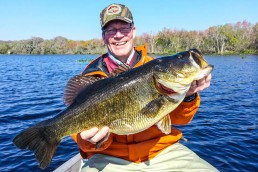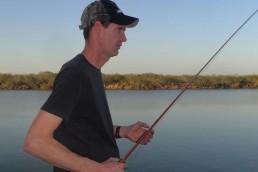Fall Recession-proof Largemouth Bass
SHARE THIS POST
In natural lakes, fall is a time of recession: Receding air and water temperatures, weed growth, forage levels, boat traffic and angler activity. Everything above the surface appears to be slowing down, while the aquatic environment below is apparently winding down to a gentle lull. Or is it?
Looks can be deceiving. Because at the same time, the fall bite for largemouth bass can actually be accelerating—especially for the largest bass in the lake!
To understand this contradiction, let’s examine changes that autumn brings to the bass’s world, and how largemouths are triggered to feed in earnest—at least until the water temperature chills to the low 40s.
The fall flurry
Cooling fall temperatures and diminishing hours of daylight trigger changes in the underwater world. Cold fall nights dropping air temps into the 40s simultaneously chill the shallows into the 50s or less, causing the shallowest weeds to begin turning brown and dying. As this occurs, bass which had previously used lily pads and other shallow weed growth as summer habitat, begin retreating deeper, typically onto adjacent mid-depth flats.
With protective weed cover thinning, forage fish become more exposed and vulnerable. Largemouths go on the attack, scouring the flats for easy meals. Bass can be nearly anywhere that healthy green weed growth remains, but the trend is clear.
Further weeks of steady cooling soon begin taking a toll on mid-depth weed growth as well, evidenced by weed tops leaning over, turning brown and decaying. As they do, bass begin shifting ever deeper, in favor of healthy green growth that continues to provide good cover and oxygen to baitfish and bass alike. By the time the water temperature dips much below 50 degrees, weeds atop the flats may offer bass little attractive cover; only the deepest outer perimeter of remaining healthy green weed growth remains attractive to bass, since it’s less affected by cooling surface temperatures.
Throughout the process, as suitable habitat shrinks, the transition causes bass to progressively shift deeper and gather in heavier concentrations; groups turn into schools, and schools into mother lodes. By the time the water temperature reaches the low 40s, the bulk of the larger bass in the lake may be gathered into only a few prime fall concentration spots. If you can find them, and the bass remain at all active, catches can be legendary.
Thus, the typical progression: surface temperatures of 50 to 55 degrees—bass on the prowl atop flats. Surface temps of 45 to 50 degrees—a torrid bite along deep outer weed lines where healthy weeds remain, particularly at inside turns (corners) in the weed line that collect bass like magnets.
And finally, alas, a general slowdown of bass activity at those same deep edge spots, once water temperatures dip to about 43 degrees or less. Bass can still be caught in these areas, particularly when a little calm weather and sunlight penetration seeps down onto their noggins, spurring short spurts of activity. The rest of the time, it’s catch as catch can.
So, we know the basic bass fall locational game plan. Now we need a game plan for how to catch ‘em at each stage of the game.
The flats bite—50 to 55 degrees
It’s coverage time, using horizontal lures to cover water in search of active bass. When you find them, thunk! Fish on. Get the fish in, get the bait out again, and catch a few more before moving on. All sizes mixed together, too—typical of bass on the move.
This is prime time to fan cast weed flats with large 1/2-ounce tandem spinnerbaits sporting two Colorado blades for maximum pulsation. There’s nothing fancy about the technique. Just cast out, crank and wind, usually within a few inches of the surface. Sometimes, try holding your rod tip high, reeling a little faster, to make the blades bulge the surface. Other times, let the bait sink a second or two on entry, then pop the rod tip to get the blades turning, and bring the lure back, occasionally touching the tops of the weeds. Let the bass tell you what works best.
Most of the time during this phase, bass will attack pretty much anything you toss their way—perhaps even surface baits or shallow-running crankbaits—until the water cools further and bass begin shifting deeper, out to the deepest edges of the weeds.
Point to consider: The flats bite doesn’t suddenly change to the edge bite overnight, like flipping a light switch. It’s a transition. At times, you’ll see active bass in both areas—maybe even 50/50 on occasion—with the odds generally going to one or the other depending on the water temperature and stage of transition.
The edge bite—45 to 50 degrees
Are you enjoying this post?
You can be among the first to get the latest info on where to go, what to use and how to use it!
During the early edge bite, it’s a combination of fluttering and penetration time. When bass are very active, use lures like single-bladed spinnerbaits to fish down the outer edges of deep weed lines for active biters. Position your boat outside the deep edge, cast onto the flat, retrieve your bait out to the edge…and then just let it flutter down, nearly tickling the outside edge of the weeds.
The reason for a large, single-bladed bait is that it tends to flutter better than a tandem, where the front and back blades often interfere with each other on the drop. (Try a tandem, perhaps a Colorado/willow bladed-combo, to see if this occurs; if there’s no tangling problem, use it!) If you want another option, try a vintage bait like the old Shannon Twin Spin, which has two side-by-side wire arms, each with its own single blade, designed for fluttering. Problem is, few bass anglers stock this option in their tackle boxes any more, although it’s still effective, particularly when you add some form of trailer to the large single hook.
Eventually, as the water cools further into the later edge bite, bass often shift their preference to 1/2-ounce weedless flippin’jigs, typically dressed with some form of large soft plastic trailer like a craw or creature. (In the old days, it was a #11 Uncle Josh Pork Frog. But once again, few anglers carry that style of dressing anymore, preferring the variety of sizes, shapes and colors provided by soft plastic.)
These jigs allow you to penetrate and probe the outer growth to locate by feel the best stands of healthy weeds. Their bulk and profile simultaneously triggers big, hungry bass to bite at this time of year.
Cast from the outer edge into the weeds, and let the jig sink. If it hangs up on the weeds, use an upward pop of your rod tip to flick it off the weeds, letting it fall again—eventually to the bottom, outside or barely within the weed edge. Let it sit a bit, anticipating that some big green monster is eyeballing and salivating over your lure. If you don’t get a bite, reel in and repeat the process.
Eventually, when you encounter a group/school/horde of bass, thunk! Slam the hook home, and jerk the fish a few feet up and away from the spot, both to avoid tangling in the weeds, and to avoid spooking its fellow bass. Heavy flippin’ sticks spooled with 20-pound-mono or 30- to 40-pound-test braid are ideal for manhandling them. Get the bass in, toss it back, and zing your lure back into the same spot to get another one…or two…or 10 or more. Remember, at this stage of the game, they’re likely to be bunched and belligerent, ready to chomp.
Remember, somewhere along that outer weed edge, there will be healthier clumps, points, corners, weeds abutting a steeper drop-off—something—that attracts all or most of the bass in the area to plunk down inside one small hidey-hole. Be observant, feel and decipher the health and type of weed cover, find that key megaspot, and you’ve got ‘em nailed!
The secret weapon—45 degrees and down
Down past about 43 degrees, when largemouth bass become noticeably lethargic, it’s creepin’ time, using slow, “do nothing” crawls and long pauses of lures with little inherent action. This tactic provides excrutiatingly long looks at your offerings to help convince inactive bass into sliding over a few inches and gently sip in your bait, rather than strike it.
When you find ‘em…well, you may catch a few, or a boatload, or not many at all, even in the right spot, depending on the day and their level of activity. You won’t know which until you try.
The keys to catching bass at this time are confidence and patience, matched with the right lure type. Hard to believe as it is, you can often beat a jig and soft bait attractor by switching to Senko-style, weighted stick worms, perhaps impregnated with salt. Importantly, rather than hooking them wacky style, through the middle, to make them flutter downward, you can minimize any action by simply threading the worm headfirst onto a small mushroom head jig; just make sure it has a large enough hook to accommodate the bulky worm. Now, when it sinks, there will be little to no inherent flop and flutter. Kinda like an oversized Ned rig.
As an alternative, rig the worm on a shaky head jighead, or as a lightly weighted Texas rig. The point is, rig it on one end, with little weight, which forces you to fish it super slowly. And, there’s just something magical about a stick worm vs. a normal thinner worm, or even a traditional weedless, bulky jig and trailer, in these cold-water conditions. Something you need to experiment with and see for yourself.
Since bass aren’t likely to attack a quick, searching approach in such cold water temperatures, it’s best to focus your efforts on areas where past experience tells you that bass are located. This confidence gives you the patience to fish super slowly, perhaps even anchoring within casting distance, and measuring each cast in minutes, rather than seconds.
Cast out, let the bait settle for an extended time, then lift the rod tip to slide it a few inches—and stop. Wait maybe 10 or more (30?) seconds (if you can stand it), and repeat. Remember, you’re trying to alert, tease and taunt reluctant or inactive bass. When they eventually bite, it will likely be a very light, almost unnoticeable pickup, rather than a bump.
Despite their inactivity, if you’re in the right place, at the right time, using this deadly tactic, you can extract some legendary catches where large numbers of big bass pack into small wintering spots. If you do, chances are you’ll be the only boat out on the lake—or at least the only one fishing appropriately.
Armed with this game plan, tailoring your approach to bass location and activity based on water temperature, you can follow largemouth bass throughout their fall transition. This requires using tactics that range from aggressive coverage to precise targeting to pinpoint extraction. They all play a critical role in fall bass fishing success.
MWO
SHARE THIS POST
Did you enjoy this post?
You can be among the first to get the latest info on where to go, what to use and how to use it!
Dave Csanda
Dave Csanda has enjoyed 40 years in the fishing communications industry at In-Fisherman, Angling Edge and now, as editor of MidWest Outdoors. He is an inductee of both the Minnesota and National Fresh Water Fishing Halls of Fame.



